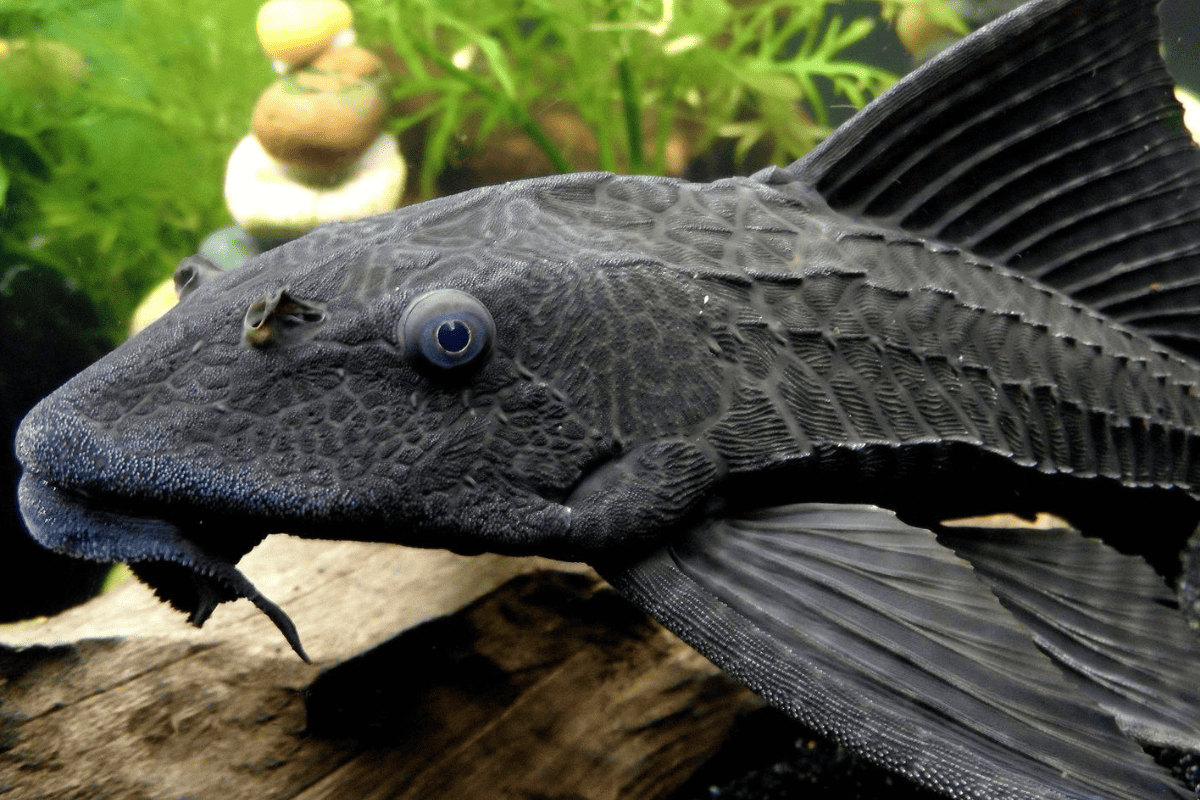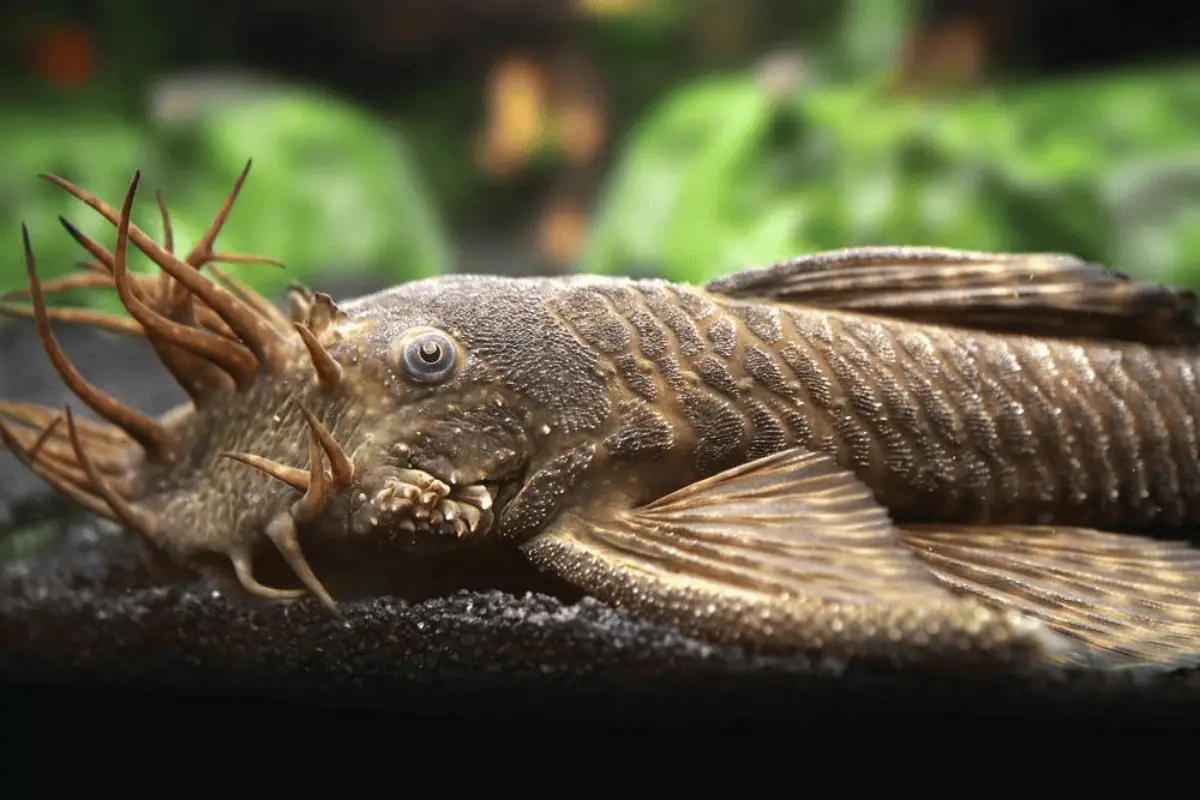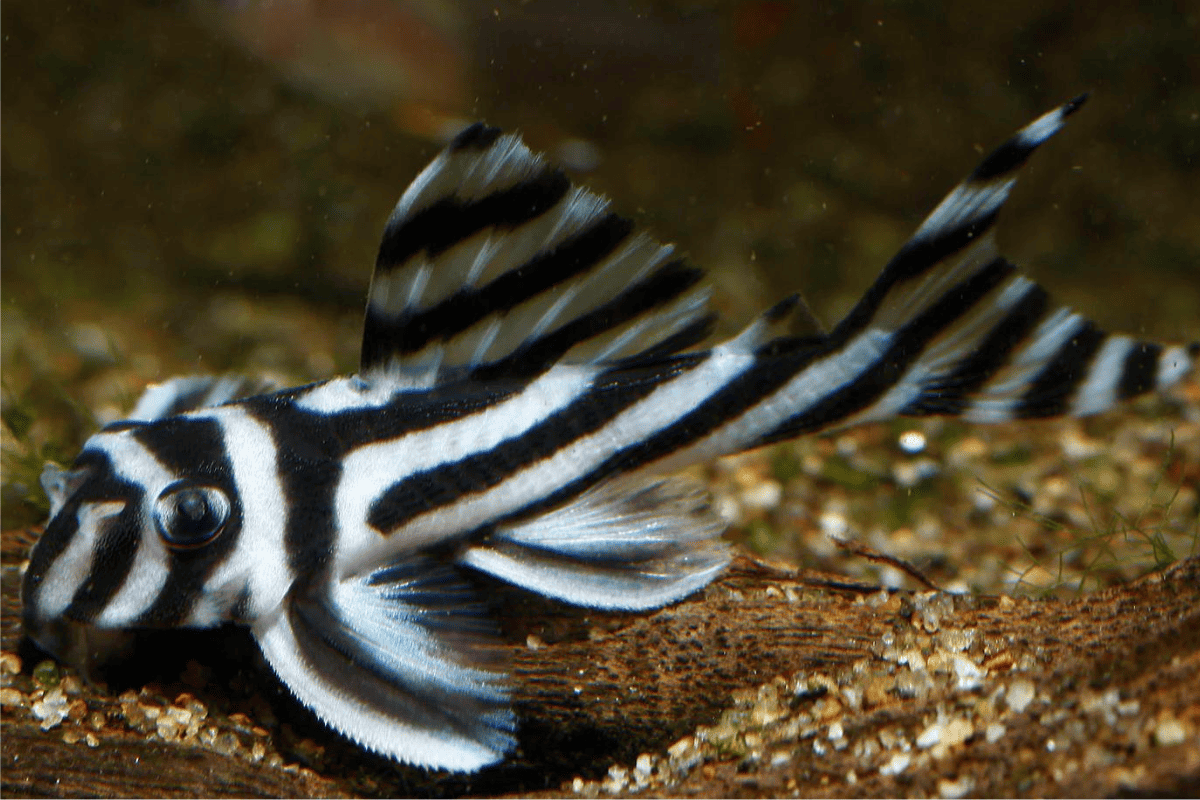Many fish owners know that Plecos are scavengers. But does it mean they will eat anything they encounter in the tank?
What about dead fish? Will Plecos eat them?
Can you rely on them to get rid of the diseased species? Which Pleco types are more likely to eat them? Should you change the water afterward?
In this article, I’ll answer all these questions and many more, so you leave with all the information you need. Let’s get started.

Will Plecos Eat Dead Fish?
Yes, some Plecos will eat dead fish. However, it’s not a primary dietary preference for many species.
- Natural Scavengers: Plecos are known to scavenge for food, and a deceased fish can become an opportunistic meal.
- Diet Variation: While some Plecos are herbivores, many have omnivorous diets and won’t shy away from protein sources, including dead fish.
- Opportunistic Behavior: If a Pleco is hungry and stumbles upon a dead tank mate, there’s a likelihood it might nibble on it.
- Species Matters: Species like the Common Pleco (Pterygoplichthys pardalis) are more likely to eat dead fish compared to specialized species like the Zebra Pleco (Hypancistrus zebra).
- Tank Conditions: Plecos in overstocked or inadequately fed conditions might show a higher propensity to consume dead fish due to competition and limited resources.
Also Read: What Do Plecos Eat?
Which Pleco Species Are More Likely to Eat Dead Fish?
Here are eight Pleco species most likely to consume a dead fish if they encounter one:
1. Common Pleco (Pterygoplichthys pardalis)

This Pleco is a known scavenger, often turning to available food sources in the tank. They’re quite adaptable and might resort to dead fish if found.
- Omnivorous Diet: Common Plecos consume a variety of foods, from algae to small organisms, making dead fish within their dietary range.
- Large Size: Growing up to 24 inches, their size makes it feasible to consume bigger morsels, including dead tankmates.
- Tank Behavior: Often observed scouring the bottom for food, these Plecos might encounter and eat deceased fish.
2. Suckermouth Catfish (Hypostomus plecostomus)

This species, often mistaken for the Common Pleco, has a similar scavenging nature. They might turn to dead fish, especially if other food is scarce.
- Less Specialized Diet: Unlike some Plecos, they’re not strict herbivores, increasing the likelihood of consuming meat.
- Environmental Adaptation: In the wild, they’ve been seen eating various materials, suggesting adaptability in diet.
- Tank Observations: Many aquarists have noted their propensity to investigate, and sometimes eat, fallen comrades.
3. Royal Pleco (Panaque nigrolineatus)

Though largely wood-eating, this Pleco can be opportunistic. They might occasionally turn to dead fish, but it’s not a primary preference.
- Wood-Centric Diet: Most of their diet consists of wood, but they can digest other organic matter.
- Tank Mates: While they coexist peacefully, a dead fish can become an unexpected snack.
- Size and Jaw Structure: Their robust jaw can handle wood but can also break down meaty substances.
4. Three Beacon Pleco (Leporacanthicus triactis)

Primarily carnivorous, this Pleco is more inclined than others to consume meaty foods. A dead fish in the tank is right up their alley.
- Meat-Loving Nature: Their natural diet is rich in proteins from invertebrates and other meat sources.
- Active Predatory Behavior: In the wild, they actively hunt for food, making a dead fish an easy target.
- Tank Dynamics: In a tank setting, they’re more alert to potential food items, including deceased tankmates.
5. Sailfin Pleco (Glyptoperichthys gibbiceps)

Being omnivorous with a leaning towards plant matter, Sailfin Plecos may consume dead fish opportunistically, especially in food-scarce situations.
- Dietary Flexibility: Though they prefer algae and plants, they can and do eat meaty foods when available.
- Tank Behavior: Their active scavenging behavior makes them likely to find and consume deceased organisms.
- Aquarist Observations: Many owners have seen them nibbling on dead fish, especially if other food sources are low.
6. Bristlenose Pleco (Ancistrus sp.)

A smaller Pleco species, the Bristlenose primarily consumes algae but can be opportunistic in the presence of a dead fish.
- Algae Preference: Their main diet is algae, but they don’t shy away from supplementary foods.
- Compact Size: Usually reaching 4-6 inches, they’re more selective but can still nibble on deceased fish.
- Tank Encounters: Due to their active nature, Bristlenoses frequently come across and might sample dead tankmates.
7. Snowball Pleco (Hypancistrus inspector)

This Pleco is largely carnivorous, making a dead fish a potential menu item, especially if it’s freshly dead.
- Protein Lover: Their diet consists mostly of meaty foods like insect larvae and crustaceans.
- Active Nocturnal Behavior: Being more active at night, they might come across and consume deceased fish unnoticed.
- Aquarium Feedings: When fed meaty foods in the aquarium, it’s evident they can and will consume dead fish if found.
8. Zebra Pleco (Hypancistrus zebra)

A coveted and beautiful Pleco, the Zebra Pleco is primarily carnivorous. A dead fish can be a source of protein for them.
- Diet in the Wild: They mostly feed on invertebrates, making fish meat not too far off their dietary spectrum.
- Tank Preferences: In captivity, they often consume high-protein foods, aligning with a potential interest in dead fish.
- Behavioral Traits: Their explorative nature might lead them to find and sample dead tankmates.
It’s worth noting that many plecos may opportunistically nibble on dead fish if they come across them, especially if they’re hungry.
But they may not actively seek out and consume dead fish as a primary food source. Here’s a list based on general behavior and dietary preferences, but individual behavior may vary:
| Pleco Species | Eat Dead Fish? |
| Common Pleco (Pterygoplichthys pardalis) | Yes |
| Goldfinned Pleco (Parotocinclus spilurus) | Yes |
| Rhino Pleco (Pterygoplichthys scrophus) | Yes |
| Gold Spot Pleco (Hypostomus luteus) | Yes |
| Chocolate Pleco (Panaque maccus) | Yes |
| Spotted Pleco (Pterygoplichthys gibbiceps) | Yes |
| Three Beacon Pleco (Leporacanthicus triactis) | Yes |
| Sailfin Pleco (Glyptoperichthys gibbiceps) | Yes |
| Royal Pleco (Panaque nigrolineatus) | Yes |
| Suckermouth Catfish (Hypostomus plecostomus) | Yes |
| Bristlenose Pleco (Ancistrus spp.) | No |
| Sunshine Pleco (Scobinancistrus aureatus) | No |
| Gold Stripe Panaque (Panaque armbrusteri) | No |
| L134 Leopard Frog Pleco (Peckoltia compta) | No |
| Medusa Pleco (Ancistrus ranunculus) | No |
| Blue-eyed Pleco (Panaque suttoni) | No |
| Rubber Lip Pleco (Chaetostoma formosae) | No |
| Vampire Pleco (Leporacanthicus galaxias) | No |
| Snowball Pleco (Hypancistrus inspector) | No |
| Butterfly Pleco (Dekeyseria pulchra) | No |
| Green Phantom Pleco (Hemiancistrus subviridis) | No |
| Blue Panaque (Panaque cochliodon) | No |
| King Tiger Pleco (Hypancistrus species) | No |
| Clown Pleco (Panaqolus maccus) | No |
| Zebra Pleco (Hypancistrus zebra) | No |
When Should I Remove a Dead Fish If a Pleco Ignores It?
You should remove a dead fish from your tank immediately, regardless of whether your Pleco shows interest.
Dead fish can lead to water quality issues and potential health problems for other tank inhabitants.
- Decomposition: As fish decompose, they release ammonia, which can spike tank levels and harm fish, including Plecos.
- Disease Prevention: Leaving a dead fish can spread diseases. Even if Plecos are hardy, they aren’t immune to all tank-borne illnesses.
- Unwanted Guests: Decaying matter can attract unwanted pests like snails or even lead to an increase in harmful bacterial colonies.
- Stressful Environment: Dead fish can create stress for other tank inhabitants. Plecos, sensitive to changes, might exhibit erratic behavior in such conditions.

Do Plecos Kill and Eat Other Fish?
No, Plecos typically do not kill and eat other fish. While they are opportunistic feeders, they are primarily scavengers and not predatory towards tankmates.
- Natural Behavior: Plecos are mainly bottom-dwellers and scavengers, spending most of their time grazing on algae and organic detritus.
- Aggression Exceptions: While not hunters, larger Plecos can sometimes be territorial, especially with their own kind. However, this rarely leads to fatal attacks.
- Mistaken Assumptions: If a Pleco is seen consuming a dead fish, it’s likely opportunistic and not the result of predation.
- Tank Observations: Most aquarists report peaceful coexistence between Plecos and other fish, noting any aggression is territorial and not predatory.
Is It Okay to Let Plecos Eat Dead Fish?
No, it’s not recommended to let Plecos eat dead fish. While they might be attracted to the deceased tank mate, there are several potential risks associated with this behavior.
- Decomposition Toxins: Dead fish release harmful substances as they decompose. Plecos ingesting this can be exposed to these toxins.
- Disease Transmission: The dead fish might have died from a disease. Letting Plecos eat it risks transmitting that disease.
- Unbalanced Diet: Relying on dead fish can disrupt the Pleco’s dietary needs, leading to potential health issues over time.
- Water Quality: Even if the Pleco consumes the fish, the process of decomposition can degrade water quality, affecting both Plecos and other tank inhabitants.
What in the Tank Eats Dead Fish?
Various tank inhabitants might consume dead fish either opportunistically or as a part of their natural behavior.
These creatures, while integral to the tank ecosystem, can play different roles in decomposition.
- Catfish Varieties: Many catfish species, such as Corydoras or Pictus catfish, may opportunistically feed on deceased tankmates.
- Crabs and Shrimps: Many bottom-dwelling invertebrates, like Red Cherry Shrimps or freshwater crabs, may feed on dead fish remains.
- Carrion-eating Fish: Some carnivorous fish, like certain loaches or freshwater eels, might take advantage of a dead fish as a food source.
- Aquatic Worms: In some cases, detritus worms or other small organisms might break down and consume decaying fish remains, although these are often unnoticed by the aquarist.
- Snails: Detritivorous snails, such as Malaysian Trumpet Snails or Ramshorn Snails, often consume decaying organic matter, including dead fish.
Also Read: Do Plecos Eat Snails?

What Happens If Fish Eat a Dead Fish?
If fish, including Plecos, eat a dead fish, they may be exposed to potential toxins, diseases, or imbalances in their diet.
While it might seem like a natural scavenging behavior, there are underlying risks involved.
- Disease Exposure: The dead fish might have succumbed to a disease, and by consuming it, fish like Plecos might be directly ingesting pathogens.
- Toxin Intake: As a fish decays, it releases harmful substances. Consuming these decomposed tissues might introduce toxins to the fish’s system, potentially affecting their health.
- Dietary Disruption: Continual consumption of dead fish can lead to nutritional imbalances. Plecos, for instance, need a varied diet and over-reliance on such a food source might compromise their overall well-being.
Also Read: Do Plecos Eat Fish Poop?
Should I Change the Water After a Fish Dies?
Yes, after a fish dies, it’s advisable to perform a partial water change.
This helps ensure the tank environment remains healthy and reduces the risk of any potential issues for other tank inhabitants, including Plecos.
- Ammonia Spike: Dead fish begin to decompose quickly, releasing ammonia. A partial water change of around 25-30% can help dilute this toxin.
- Disease Prevention: Changing the water can help reduce the risk of any potential pathogens that might have caused the fish’s death from affecting other tank residents, such as Plecos.
- Water Quality Maintenance: Even without obvious signs, the death might indicate a water quality issue. Fresh water helps reset the balance.
- Stress Reduction: A cleaner environment reduces stress for the remaining fish. Plecos, being sensitive to changes, will benefit from this.
- Regular Testing: After changing the water, regularly test the water parameters. Ensure levels, especially of ammonia and nitrites, are in the safe range for your Plecos and other fish. I personally use the API FRESHWATER MASTER TEST (link to Amazon).

Conclusions
For those of you in a rush, here’s a short summary:
- Some Plecos are opportunistic scavengers and will eat dead fish when available, but it’s not a primary dietary preference for many species.
- The likelihood of a Pleco eating a dead fish depends on its species, with species like the Common Pleco being more prone to consuming deceased tankmates.
- Dead fish should be promptly removed from the tank to prevent water quality issues, disease transmission, and stress for other tank inhabitants.
- Plecos are generally not predatory towards other fish and are primarily bottom-dwelling scavengers, but larger Plecos can exhibit territorial aggression.
- It is not recommended to let Plecos eat dead fish, as it can expose them to toxins, diseases, and disrupt their dietary balance, potentially leading to health issues.

